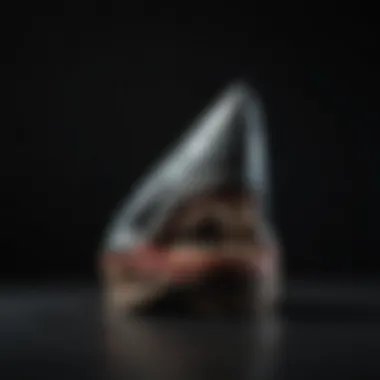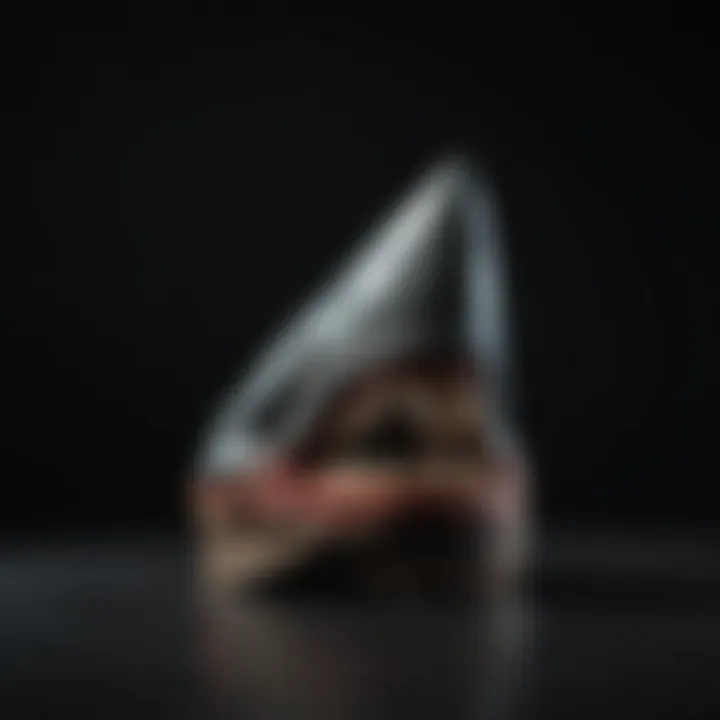The Most Expensive Megalodon Tooth: An In-Depth Exploration


Intro
Megalodon teeth represent one of the most sought-after collectibles in the fossil market. These teeth, relics of a creature that dominated the oceans millions of years ago, have captivated collectors and researchers alike. With their impressive size and unique historical significance, megalodon teeth are more than simple fossils; they are symbols of ancient power and mystery. As we explore the varying factors contributing to their value, preservation techniques, and the bustling marketplaces surrounding their collection, we will uncover the depths of fascination that make these artifacts so popular.
Featured Collectible of the Month
Overview
This month, we turn our attention to a remarkable megalodon tooth that recently fetched an astounding price at auction. This specimen, measuring over seven inches in length, exemplifies the rarity and desirability associated with high-quality megalodon teeth. Its impressive dimensions, coupled with a pristine condition, elevate its status within fossil circles. Collectors are acutely aware of how factors like size, color, and preservation influence pricing, and this tooth embodies those qualities.
Historical Significance
Megalodon, scientifically known as Carcharocles megalodon, lived approximately 23 to 3.6 million years ago. This apex predator is believed to have reached lengths of up to 60 feet, preying on large marine animals. The teeth of the megalodon are robust and serrated, reflecting their ability to grasp and slice through prey.
Historically, these teeth have not just served as tools for understanding prehistoric life; they also provide insight into the ecological dynamics of ancient oceans. Collectors value these artifacts not only for their beauty but also for the stories they tell about the Earth’s evolutionary history. Each tooth is a fragment of a narrative woven from the fabric of time, connecting us to a world long vanished.
Identification Techniques
Visual Characteristics
Identifying genuine megalodon teeth involves understanding key visual characteristics. The most notable features are:
- Size: Real megalodon teeth are significantly larger than those of modern sharks.
- Shape: They are triangular with finely serrated edges, ideal for their predatory role.
- Color: While colors can vary, hues of black, brown, and gray are common, often influenced by sediment during their fossilization.
Resources for Identification
Several resources can assist collectors in identifying authentic megalodon teeth. Notable ones include:
- Field Guides: Books dedicated to fossils often contain images and descriptions to aid in identification.
- Online Forums: Communities like those found on reddit.com provide platforms for discussion and sharing of experiences.
- Museums: Visiting natural history museums can offer insight into what to look for and how to authenticate specimens.
"Understanding the unique characteristics of megalodon teeth not only enhances the collecting experience but also preserves their legacy in the minds of collectors."
By employing these strategies, collectors can navigate the intricate world of fossil collecting with greater confidence.
Prolusion to Megalodon Teeth
Megalodon teeth are more than mere fossils; they are valuable relics that capture the imagination of rock and fossil collectors. Understanding the significance of these teeth is crucial for anyone delving into the world of paleontology or fossil collecting. This article seeks to explore various aspects surrounding megalodon teeth, especially focusing on the most expensive specimens and what drives their value.
Defining the Megalodon
The megalodon, scientifically known as Carcharocles megalodon, was a colossal shark that roamed the oceans approximately 23 to 3.6 million years ago. It is often considered one of the largest predators in Earth's history, with estimates suggesting it could reach lengths of over 60 feet. These sharks had teeth that were particularly well adapted to their carnivorous diet, featuring serrated edges designed for slicing through flesh. The size and shape of these teeth are among the features that enchant collectors and researchers alike.
The megalodon played a crucial role in its ecosystem, influencing marine life during its time. Its existence prompts questions about predator-prey dynamics and the evolutionary pathways leading to modern shark species. Evidence of the megalodon largely comes from its teeth, as they are much more commonly preserved than skeletal remains. Often, the discovery of megalodon teeth can provide insights into the environment and climate of the periods in which they lived.
Significance of Teeth in Evolutionary Studies
Megalodon teeth are significant in evolutionary studies for several reasons. Firstly, they serve as a primary source of information about the species, offering clues about its size, feeding habits, and even its geographic distribution. Paleontologists have noted that the morphology of megalodon teeth reflects its evolution. The gradual changes in size and shape over millions of years indicate adaptations to different types of prey and changes in habitat.
Additionally, the megalodon is often used as a benchmark in studies that compare prehistoric marine ecosystems with today’s. By examining megalodon teeth, scientists can gather data related to biodiversity, extinction events, and climate change. These teeth also help fill gaps in the fossil record, providing a bridge between ancient marine life and current species.
Understanding the Value of Megalodon Teeth
Megalodon teeth are not merely fossilized remnants of an ancient predator; they represent a fascinating cross-section of natural history and human interest. The value of megalodon teeth can be seen as a composite of various factors including rarity, condition, and market dynamics. This section will examine these elements in detail, enabling collectors and enthusiasts to gain a deeper appreciation for what makes certain specimens more desirable than others.


Market Factors Influencing Price
The market for megalodon teeth is influenced by several factors that dictate their pricing. These factors are not static; they fluctuate based on supply and demand, trends in fossil collecting, and even the emergence of new specimens.
- Demand Among Collectors: Interest in megalodon teeth has surged in recent years, drawing attention from collectors around the globe. The popularity of these teeth is fueled by their historical significance and the allure of owning a piece of natural history.
- Economic Conditions: Broader economic factors can also shape the marketplace. During economic booms, collectors might spend more on high-quality samples, while recessions can lead to reduced spending.
- Cultural Interest: Documentaries and media coverage about prehistoric creatures increase public fascination. This can elevate the prices at which certain specimens are traded.
- Geographical Availability: The location from which a tooth is sourced can also impact its value. Teeth found in areas known for yielding superior specimens can fetch higher prices than those from less notable sites.
Condition and Authenticity
Condition plays a crucial role in the valuation of megalodon teeth. Collectors are often very discerning. They look for teeth that are well-preserved, without excessive damage or restoration. Several key aspects influence condition:
- Natural Wear: Minor wear caused by natural processes is often acceptable, while significant chips or fractures are deal-breakers.
- Restoration: Teeth that have been restored, even if done expertly, can suffer in market value compared to wholly intact specimens. Collectors may prefer unaltered pieces, despite the condition.
- Visual Appeal: The color and surface texture can enhance or diminish the desirability. Glossy finishes and unique colors often draw attention and increase value.
Authenticity is another concern that collectors face. Counterfeit fossils exist in the marketplace, and verifying a tooth’s legitimacy is critical. Successful authentication can stem from examining specific traits, acquiring provenance records, or consulting with experts in the field.
Size and Rarity
The size of a megalodon tooth fundamentally contributes to its value. Larger specimens are often highly desirable, as they are inherently rarer. Here are important points related to size and rarity:
- Length: Teeth exceeding five inches are particularly prized and can command astronomical prices. The largest known megalodon specimen teeth can fetch tens of thousands of dollars.
- Rarity: Rarity is a function of both the size and the condition. Specimens in pristine condition that also boast substantial length are exceedingly rare. Collectors often seek these out, driving prices higher.
- Location: Certain locales are known for yielding larger megalodon teeth. For example, teeth from the coastal regions of North Carolina or Florida often have higher demand due to their historical context and quality.
In summary, understanding the factors that influence the value of megalodon teeth is crucial for collectors and investors alike. By considering how market factors, condition and authenticity, and size and rarity come into play, one can make informed decisions in acquiring these remarkable pieces of history.
Famous Megalodon Teeth and Their Prices
Famous megalodon teeth represent not only significant paleontological finds but also hold a unique place in the collecting market. These teeth, often displayed in prestigious collections, come with stories and histories that enhance their allure and value. Understanding the prices of these famous pieces allows collectors to better navigate their own pursuits in fossil collecting. In addition, these teeth often reflect larger trends within the fossil market, making them crucial for anyone interested in this field.
Notable Sales Records
Certain megalodon teeth have fetched astonishing prices at various auction houses and private sales. One remarkable sale occurred in 2022 when a pristine 6.5-inch megalodon tooth sold for over $100,000. This tooth's exceptional condition and size made it a coveted item among collectors and enthusiasts alike. Another significant sale happened in 2019, where a 7.5-inch specimen was auctioned for $150,000. These records exemplify the high demand and value associated with megaldon teeth, solidifying their status as one of the most sought-after fossils in the world.
Auction Dynamics
The dynamics of auctions play a crucial role in determining the final price of megalodon teeth. Factors such as the reputation of the auction house, the marketing strategy deployed, and the presence of competitive bidders influence the results. Typically, renowned auction houses like Sotheby's or Bonhams attract serious collectors.
Bidders become emotionally invested, often driving prices higher than expected. Furthermore, many auctions have a reserve price, ensuring that sellers obtain at least a minimum amount for their fossils. The thrill of auction dynamics amplifies the excitement and the final prices reached, making each transaction unique.
Private Collectors and their Specimens
Private collectors often possess some of the most fascinating megalodon teeth. These individuals sometimes build extensive collections that showcase not only the beauty of the teeth but also their varied histories. Collectors often attend fossil shows or utilize platforms like Reddit and Facebook groups to network and acquire new specimens.
Some well-known collectors have transformed their homes into displays of megalodon teeth, emphasizing the significance of these artifacts in both science and personal heritage. These collectors frequently share their experiences and insights, helping others navigate the complex world of megalodon teeth collecting.
In the end, the combined narratives of notable sales, auction strategies, and private collections create a rich tapestry that informs the value and significance of megalodon teeth in today’s market.
The Marketplace for Megalodon Teeth
The marketplace for megalodon teeth serves as a critical aspect of fossil collecting. It connects collectors with unique specimens, providing insight into their historical value and significance. This section explores various elements that contribute to the marketplace, including physical shows, online platforms, and collector networks. Understanding these aspects helps both novice and seasoned collectors navigate the complexities of acquiring megalodon teeth.
Physical Fossil Shows
Physical fossil shows are important events where enthusiasts gather to buy, sell, and trade specimens, including megalodon teeth. These shows offer a first-hand opportunity to examine the quality and authenticity of teeth.
Vendors often display their finest pieces, attracting serious collectors. Attendees can directly interact with sellers, which enhances the buying experience. The communal atmosphere fosters connections among collectors, creating a vibrant culture of exchange. Notable shows occur annually, like the Tucson Gem & Mineral Show, where participants can find rare specimens.


However, potential buyers should ensure they evaluate pieces carefully. Here are some considerations for navigating these events:
- Authenticate the tooth.
- Consider the provenance of the specimen.
- Discuss pricing openly with sellers.
Online Marketplaces
The rise of online marketplaces has transformed how collectors engage with the megalodon teeth market. Platforms like eBay, Facebook Marketplace, and specialized fossil websites allow collectors to browse a wider variety of specimens from all over the globe.
These platforms have benefits like convenience and accessibility. A collector can make a purchase from the comfort of their home, which saves both time and effort. However, buyers need to be cautious about authenticity claims made online, as it can be challenging to verify the credibility of sellers.
Here are some tips for successful online purchasing:
- Check seller ratings and reviews.
- Ask for detailed photographs from different angles.
- Be aware of returns and refund policies.
Collector Networks
Collector networks play an essential role in the megalodon teeth community. These groups offer a platform for sharing knowledge, trading specimens, and connecting with like-minded individuals. Often found on social media or through dedicated forum sites like Reddit, these networks can be invaluable for both new and experienced collectors.
Participating in these networks allows collectors to gain insights into market trends, ethical collecting practices, and preservation techniques. Collectors can also learn about upcoming shows and events that may feature megalodon teeth.
Some of the most popular collector networks include:
- Facebook fossil collector groups.
- Reddit threads focused on fossils.
- Local geological societies.
Care and Preservation of Megalodon Teeth
The care and preservation of megalodon teeth are essential for maintaining their integrity and value. Given their rarity and significant cost, proper maintenance becomes critical for collectors. Understanding these practices can help enhance the longevity of these unique fossils, making them not only aesthetically pleasing but also historically significant artifacts.
Cleaning and Maintenance Techniques
Cleaning megalodon teeth involves more than just a simple wipe down. It is crucial to utilize techniques that do not damage the fossil. Many collectors prefer a gentle approach that includes:
- Soft Brushes: Use a soft-bristled brush to remove dust and dirt. This prevents scratching the surface of the tooth.
- Mild Soaps: In cases of stubborn grime, a diluted mild soap solution can be used. Avoid harsh chemicals that may erode the enamel.
- Drying: After cleaning, ensure that the teeth are thoroughly dried. Moisture can promote mold or deterioration.
Maintenance is not limited to cleaning. Regular inspections are advisable to catch any potential damage early, such as cracks or discoloration, which might necessitate deeper restoration efforts.
Storage Solutions for Preservation
Storing megalodon teeth correctly is vital for their preservation. Environmental factors could negatively impact their condition. Here are several recommended storage solutions:
- Display Cases: Using UV-protected display cases prevents exposure to harmful sunlight and dust. This not only showcases the tooth but protects it.
- Temperature and Humidity Control: Keeping the teeth in a controlled environment is important. Fluctuations in temperature and humidity can lead to warping or cracking.
- Padding and Support: When storing teeth, use materials like acid-free tissue or cotton to cushion them. This is to prevent movement and potential damage.
Proper care and preservation of megalodon teeth ensures these ancient treasures continue to captivate future generations, respecting their irreplaceable historical context.
In summary, focusing on cleaning, maintenance, and storage ensures the megalodon teeth not only retain their beauty but also their value in the collector's market. Engaging in these practices allows collectors to appreciate these fossils in their best condition.
Legalities Surrounding Fossil Collecting
Fossil collecting, especially ancient specimens like megalodon teeth, raises various legal concerns that collectors must navigate. Understanding these legalities is crucial to ensure that the acquisition and ownership of these fossils are conducted properly and ethically. Many regulations and guidelines exist that reflect a growing awareness of the importance of maintaining natural heritage, promoting responsible collecting practices, and protecting archaeological sites. Fossil collectors must be informed about these considerations, as they can significantly impact the way they participate in the hobby.
Ownership Rights and Regulations
Ownership rights for fossil specimens, including megalodon teeth, are primarily governed by local, national, and sometimes international laws. The legal status can vary greatly depending on where the fossil is found. In some jurisdictions, fossils discovered on private property may belong to the landowner, while in others, they may be considered property of the state or public domain.


It is also important to be aware of the Endangered Species Act or similar legislation, which can affect collecting practices. Some laws prohibit the collection of specific fossils or materials in protected areas or reserves. Failure to adhere to these regulations can result in hefty fines or legal consequences. Before purchasing a megalodon tooth, collectors should verify its provenance and ensure that it was obtained in compliance with local laws.
Ethical Considerations in Collecting
While legal frameworks delineate what is permissible, ethical considerations delve deeper into the implications of fossil collecting. Ethical fossil collecting promotes respect for the natural environment, scientific heritage, and historical significance. Collectors are encouraged to adopt practices that prioritize the preservation of fossil sites and the integrity of research.
There are several ethical principles that collectors should consider:
- Respect for Natural Heritage: Collectors should appreciate the broader environmental context and avoid disrupting ecosystems when collecting fossils.
- Documentation: Each fossil should be well-documented with records of its origin, including where and how it was collected. This information supports transparency and accountability.
- Support for Science: Engaging with scientific communities can enhance appreciation for fossils and promote responsible collecting. Donations to museums or collaborations with researchers often benefit both parties.
Ethical collecting is not only about following laws; it reflects a commitment to upholding standards that benefit the entire field of paleontology.
The Future of Megalodon Teeth Collecting
The future of megalodon teeth collecting holds substantial interest for both seasoned collectors and newcomers in the field. As trends shift and research continues, the landscape of fossil collecting is evolving. It reflects a growing understanding of the significance behind these ancient artifacts.
Trends in Fossil Collecting
The dynamics of fossil collecting are changing. There is a noticeable shift towards a more scientific approach. Collectors are not just after aesthetics; they want knowledge. This trend promotes education and research. Online platforms have made information more accessible. More people are sharing their collections and findings than ever before. This is beneficial for both the academic community and hobbyists.
Following are key trends in fossil collecting:
- Community Engagement: Social media platforms like Reddit and Facebook enhance interaction among collectors.
- Increased Popularity: Megalodon teeth, due to their historical significance, are gaining attention, attracting enthusiasts.
- Quality Over Quantity: Many opt for fewer but higher-quality items in their collections.
Collectors focus on the provenance of a piece, seeking documented history over just appeal. This trend adds another layer of value for serious collectors.
Advancements in Technology and Research
Technology is playing a crucial role in the evolution of megalodon teeth collecting. Advances enhance both collection methods and education. New tools available for cleaning and preserving, such as specialized cleaning solutions, help maintain the integrity of teeth.
Research also benefits from advances in technology. For instance, 3D scanning can create detailed models of teeth. It allows researchers to analyze forms without damaging physical specimens.
Some advancements include:
- Radiographic Imaging: Allows for internal examinations without harm.
- GIS Technology: Valuable for mapping fossil-rich locations.
- Data Sharing Platforms: Help disseminate research globally.
These advancements increase the importance of megalodon teeth in fossil studies. They help collectors understand their pieces better. Investing in megalodon teeth is not only about ownership; it fosters a deeper appreciation of history.
"The future of collecting lies in collaboration, technology, and ethics."
As the future of megalodon teeth collecting unfolds, it will shape a generation of collectors informed by both history and scientific inquiry. Understanding these elements is essential for anyone wishing to engage meaningfully in this fascinating hobby.
Ending
In exploring the most expensive megalodon teeth, this article highlights several important elements related to their significance, market value, and collector interest. The megalodon, an apex predator that ruled the oceans millions of years ago, left behind formidable teeth that now capture the imagination of collectors and researchers alike.
Understanding the various factors influencing the value of these teeth is crucial. Elements such as condition, size, and rarity can greatly impact the market. Moreover, the legalities of fossil collecting add another layer of complexity that collectors must navigate.
Furthermore, preservation techniques are vital for maintaining the integrity of these artifacts. As collectors, knowing how to care for megalodon teeth ensures that they can be appreciated for years to come. By synthesizing information on value, market dynamics, and care practices, this article serves as a comprehensive guide for anyone interested in this unique niche.
Recap of Key Points
- Definition and Historical Context: The megalodon was a massive shark known for its size and predatory skills. Its teeth provide a window into the past.
- Market Influences: Factors like authenticity and condition are key in determining the price of a megalodon tooth.
- Selling Venues: Physical fossil exhibits, online platforms, and collector networks create different avenues for buying and selling.
- Care Practices: Proper cleaning and storage of megalodon teeth are essential for long-term preservation.
- Legal Concerns: Knowledge of ownership rights and ethical considerations is crucial for responsible collecting.
Final Thoughts on Megalodon Teeth
Megalodon teeth continue to fascinate collectors and researchers due to their impressive size and historical significance. As their prices rise, understanding the factors that contribute to their value becomes increasingly important. Additionally, as technology fuelling collecting trends advances, enthusiasts must remain informed.
As you explore the world of megalodon teeth, remember the balance between collecting and ethical considerations. Whether you seek to learn more about these fascinating teeth or aim to expand your collection, knowledge will empower your journey in this unique field. Collecting megalodon teeth is not just about ownership; it's about preserving a part of natural history.



